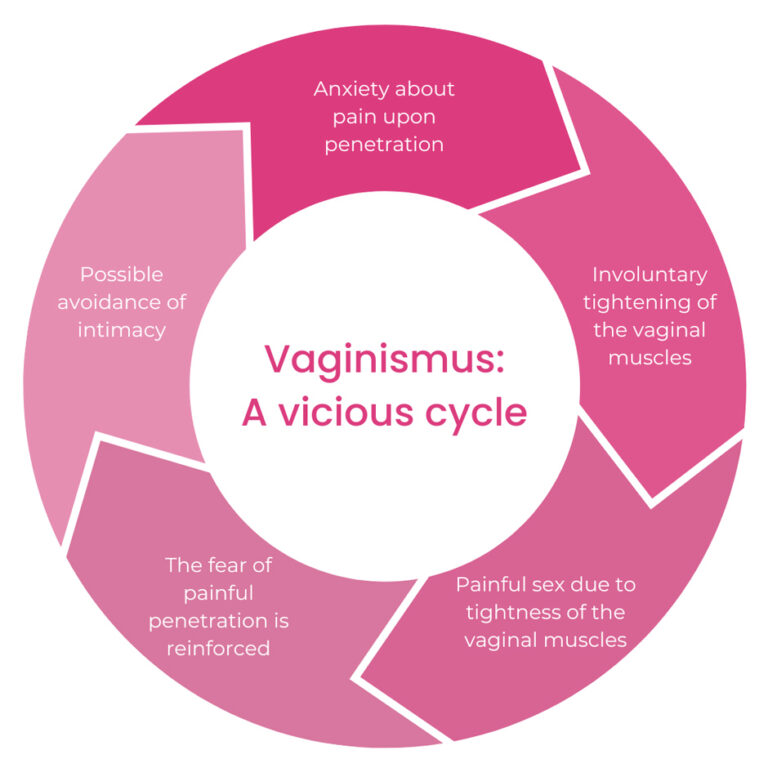It’s supposed to be one of life’s greatest joys, and yet if your partner has vaginismus, sex might have become something to dread. If you have attempted intercourse, you may be alarmed at the pain she experiences, and upset at the thought of intimacy being the cause. But however bad you feel, your partner will be feeling a lot worse. For women with vaginismus, the condition is frequently a source of shame. Denied something so normal and natural, many women with vaginismus don’t even know its name. They may have come to believe that sex is supposed to be painful, or that they simply must live a life without intimacy. Thankfully this is not the case. Here at The Gynae Centre, after years spent delivering successful vaginismus treatment, we know very well the struggles couples face. Partners with vaginismus want to know: How can I support the woman I love? What are the dos and don’ts? Is there a vaginismus cure? Read on and we explain.
What is vaginismus? Vaginismus symptoms
Vaginismus is persistent involuntary contractions of the muscles in the vagina side walls, in response to attempted penetration. This makes sexual intercourse, insertion of tampons or cervical smear tests excruciating and often even impossible.
Women with vaginismus frequently describe a sincere desire to have sex that is met with the burning, stinging pain of hitting a ‘brick wall’ when penetration is attempted. Many women with vaginismus can absolutely become aroused and enjoy other types of sexual contact without penetration.
Vaginismus is classed as a psychosexual condition because it is rooted in fear causing a protective reflex that triggers the muscle spasms. However, this clenching is involuntary and the pain is very much physical – not at all ‘in the mind’.
What causes vaginismus?
Dr Eskander, Consultant Gynaecologist at The Gynae Centre says: “In vaginismus, signals sent from the brain to the vagina are attempting to prevent pain, by causing the muscles to tighten. It’s what we call a ‘conditioned reflex’. When the brain thinks that penetration will create pain, it contracts the muscles to prevent it. This then creates resistance and pain, which reinforces the contraction reflex, which creates more pain, which reinforces the contraction reflex, and so on and so on, in a vicious cycle (see diagram). The clenching is involuntary, and the pain is very real.”
Vaginismus can be:
- Primary (as in, with her since she first attempted to have sex, insert a tampon or undergo a gynaecological examination) or;
- Secondary – This is when a woman has been able to have painless penetration in the past but somehow developed vaginismus later on. Secondary vaginismus is less common.
Sometimes vaginismus is caused by an underlying physical issue that can make penetration difficult or painful (for example thrush, an abnormal hymen, or endometriosis) which has then created the contraction reflex and set off the vicious cycle.
More commonly however, vaginismus stems from a mental block, a fear of vaginal penetration. The roots of this fear vary from woman to woman.
Vaginismus causes include:
- A condition that has created pain upon penetration (such as a hymen abnormality, thrush or endometriosis) and set off the vaginismus vicious cycle
- Underlying beliefs about sex being shameful or dirty
- A fear that her vagina doesn’t have sufficient space for penetration
- Childbirth trauma
- A painful or traumatic sexual experience
- A difficult medical screening.
Whatever the initial trigger, the vicious cycle of vaginismus is the same (see diagram).
Thankfully however, it is absolutely possible to overcome vaginismus, and for you and your partner to experience enjoyable intimacy. Effective vaginismus treatment is available.
Supporting your partner through this process will be more helpful than you can imagine. Read on for tips on how to do so.
Vaginismus and the emotions
If your partner has vaginismus, you may be feeling helpless and even frustrated – wondering if the symptoms are somehow your fault (they are not), and what you can do to help. You will understandably be reticent to talk about your own fears with your partner, since this is primarily her struggle and one she has likely been dealing with for a very long time.
If your partner has vaginismus, she may be feeling:
- Frustrated that she wants to have sex and her body is preventing her from doing so
- Misunderstood because she may have encountered partners that were not understanding and sympathetic in the past
- Afraid of being rejected by you
- Bewildered as to how to solve this problem (especially if she has tried psychological vaginismus treatment before and it hasn’t worked)
- Embarrassed to have to discuss sex in such a sensitive way early on in a relationship, especially because she may not fully understand the condition herself
- Ashamed as if the condition is somehow her fault (it is absolutely not her fault, but unfortunately many vaginismus sufferers report feeling this way)
- Despondent as to whether the problem can be solved. She may have developed a coping mechanism of avoiding the issue, especially if she has unsuccessfully tried vaginismus treatments in the past. She may even believe that there is no vaginismus cure (but in fact there is, as we explain below).
Dos and don’ts for supporting a partner with vaginismus
Don’t:
- Complain to her about the problem. She knows it’s a problem. She’s no doubt dealt with it for years.
- Make jokes about vaginismus or sexual frustration. She knows how frustrating it is. You may use humour to cope with things. But more often than not, ‘jokes’ about the problem will be interpreted as criticism.
- Get impatient. Remember she has lived with this for a long time and has likely tried to remedy it in the past with no success. Here at The Gynae Centre, vaginismus sufferers frequently come to us after trying everything they can think of, from talking therapies to getting drunk. After so much heartache, women frequently shut down. So if you’re worried she’s not ‘motivated’ to solve it, it’s probably because, as a coping mechanism, she’s tried to put it to the back of her mind.
Do:
- Learn about vaginismus so you have knowledge and insight. For example, by reading this article!
- Confide in a trusted person if you have your own fears and frustrations to deal with. Choose the person wisely though, and be careful in the way you relate to your partner about the issue. While some women with vaginismus want to know all about how their partner feels, for many others this kind of talk will be another burden for her to bear, when she may already feel guilty and embarrassed enough.
- Reassure her that you care for her and love being in her company. She is probably afraid of being rejected right now, so letting her know that you aren’t going anywhere will be helpful.
- Listen to her feelings as she opens up about this struggle.
- Practise patience around a problem that while you may find frustrating, has been a problem for her for years.
- Offer to help in any way you can, whether with attending appointments or finding information.
- Encourage her to seek vaginismus treatment. However, this needs to be done after empathetic listening has taken place. Encourage her gently and in the spirit of ‘you can do this, because you’re strong and you’re great’. (Impatiently interrupting her with ‘this is what you need to do’ is likely to backfire. Remember, the pain is hers and she has struggled with the problem a lot longer than you!)
There is hope. Many people don’t know this, but there is actually a vaginismus cure – vaginismus treatment that works in 90% of cases. Read on.
Is there a vaginismus cure? Vaginismus treatment that really works
Traditional vaginismus treatment has usually combined talking therapy with vaginal dilators. But this is often ineffective because it is very difficult to force a relaxation response when the conditioned reflex and vicious cycle are in place. While vaginismus is rooted in fear, its manifestation is a very powerful physical response, and as such physical treatment is appropriate.
As experts in vaginismus treatment, at The Gynae Centre we have found that when we incorporate physical treatment, the vicious cycle of contraction-pain-contraction-pain can be broken.
Here at The Gynae Centre we are proud to offer vaginismus treatment that is effective in around 90% of cases. The Botox cure for vaginismus, which we have been successfully delivering for well over a decade.
We have found that a significant number of women have a hymen abnormality in the form of thick hymen or abnormal septum in the middle of the hymen ring, leading to the vaginismus in the first instance. These are dealt with through minor surgery, followed by an injection of a large dose of Botox into the muscles surrounding the vaginal orifice. The procedure takes about 30 minutes under sedation as a day case and you will be discharged home after recovery after about one hour.
The hymen is then broken and removes the obstacle to penetration and the Botox itself helps to break the vicious cycle of vaginismus. The Botox temporarily relaxes the specific spasming muscles around the vagina so a woman can experience sex without pain. After she experiences sex without pain, she can then relax and begin to enjoy it, and those muscles learn to relax by themselves.
The Botox treatment lasts around four months but usually a woman will only need one treatment, because during this time the cycle will already be in place. Once the muscles have been relaxed, the woman can begin to use dilators, building up tolerance until she is ready for intercourse. Botox vaginismus treatment has been demonstrated effective in over 90% of cases at the clinic.
Left untreated, vaginismus can be incredibly damaging to a woman’s self-esteem and personal ambitions. But help is available – she doesn’t have to suffer.
For more information, book a consultation or call 020 7580 8090.







